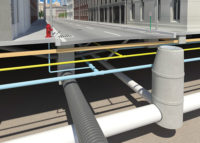
The construction industry continues to lag behind others when it comes to the adoption of digital work practices. How can the Fourth Industrial Revolution become reality without a fully digitized engineering, procurement and construction sector? As the foundation of infrastructure across the world, the construction industry has the opportunity to lead. When global construction leaders start to think digital first, our cities and industries will be propelled into the Industry 4.0 era.
That was why the World Economic Forum, in a recent Shaping the Future of Construction report, encourages construction industry executives to think strategically about the future and take preparatory steps sooner. In the report, several key imperatives are identified, including adopting advanced technology at scale and maximizing the use of data and digital models throughout processes.
So, what can technology, data and digital models bring to construction? It’s all about achieving on-time, on-budget projects with high quality and safety standards and a new level of real-time project transparency. Newer technologies such as building information modeling (BIM), prefabrication and 3D printing are already reshaping the industry. Industrial IoT (IIoT) is digitizing the construction field with numerous sensors that reports all types of data — location, speed, vibration, fuel levels, safety/environmental hazards, raw materials, finished goods, work in process — without traditional manual/paper-based data acquisition. Edge computing, the ability to deploy intelligence anywhere in the field, is processing that raw sensor data into immediate project progress and quality status. Edge computing and IIoT applications can transform the industry by maximizing the use of data and leveraging digital models to address one of the biggest challenges in EPC – real-time project visibility.
Maximize Use of Data
An industrial construction site or fabrication yard holds many sources of data — from the onboard devices in heavy equipment like cranes, bulldozers, trucks, and other moving vehicles to tools such as pumps, compressors, generators, welding machines. Yet, this data is typically in silos, available only by individual pieces of equipment or tools or proprietary to each equipment or tool vendor or the contractor using them — on-board diagnostics, vibration, environmental and other sensors, or even third-party systems like weather. Additional sensors may be needed to digitize analog assets, such as analog meters made digital through visual analytics. Integrating all the disparate data from various sources that may utilize different data structures is an important first step.
Digital Modeling
Data alone is not sufficient. In order to be useful, data needs to be analyzed in real-time, in the context of construction or fabrication operations, to make is usable. Creating dynamic digital models of equipment and processes allows not only monitoring but, with artificial intelligence-based software, can also be used for predictive analytics. Does the speed and location of moving forklifts indicate an imminent collision? Is the vibration in a pipe-cutting machine excessive over a period of time such that it requires maintenance? Does moving equipment or tanks that supply oxygen or other gases require refueling, to avoid job disruption?
By digitizing and modelling equipment and processes — a fabrication process with multiple steps — project owners and stakeholders gain real-time visibility on their projects. In contrast to manual data collection and processes often utilized today, digital construction prevents unplanned downtime, improves equipment productivity, allocation and health.
Advanced Technology
The WEF report also calls out an imperative of adopting advanced technology at scale. What are some of these advanced technologies that can be leveraged in digital construction? The advances in microcontrollers (MCUs) and System-on Chips (SoCs), which are compact and require very low power, have enabled edge computing at often remote and unconnected (or under-connected) construction sites, integrating data closest to the source. These edge computing devices are powerful enough to run operating stacks and software algorithms that incorporate artificial intelligence, so predictive analytics can be done at the pace of operations. There are certainly interesting applications in construction, such as drones with added edge computing and Industrial IoT software that can be used for inspection, safety, and location of materials or finished goods across a large construction or fabrication yard. By combining edge computing, software intelligence and an edge to cloud architecture (supporting enterprise data), a powerful and scalable architecture can be built.
Impact on Construction
Ultimately, data, digital models and advanced technology are enablers of delivering on-time, on-budget construction projects. Digital Construction projects using IIoT software and edge computing provide real-time visibility for key stakeholders. Digital construction can reduce project disruptions by increasing equipment uptime, quickly locating movable equipment, reducing idle time and decreasing unplanned downtime through predictive maintenance. It can reduce costs through predicting and leasing only the equipment required, reduce manual inaccuracies through automation, predict fuel or other consumables needs to decrease last minute ordering and surcharges and improve supply chain logistics. It can enhance worker safety and health through improved environmental monitoring.
The future of construction is built on digital transformation and the construction sector can lead the way to Industry 4.0 now.
Jane Ren is the CEO and co-founder of Atomiton. Before starting the company in 2013, Ren was the chief business architect at GE Global Software. She product-managed the industrial internet platform Predix and spearheaded software-enabled business transformation across GE’s transportation, aviation, energy and healthcare businesses. Prior to her work at GE, Ren was responsible for market strategies at Cisco, Sutter Health, and Intel Digital Health.




Post a comment to this article
Report Abusive Comment